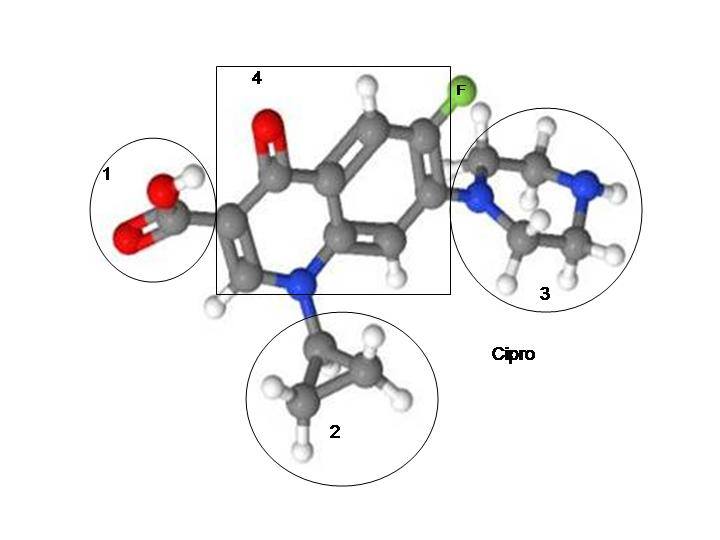I’ve read this article 14 times. I think that I understand it. It’s not an easy article to read. Actually, it’s a beast. I’m going to go over what I think are the interesting points of the article in this post. I’m also going to go over something that I think the researchers got wrong, and the implications of their false (IMO) conclusion.
Here is the article –
http://www.jimmunol.org/content/184/9/4827.full.pdf
Mitochondrial Reactive Oxygen Species Control T Cell Activation by Regulating IL-2 and IL-4 Expression: Mechanism of Ciprofloxacin-Mediated Immunosuppression
The Journal of Immunology, 2010, 184: 4827–4841.
Marcin M. Kamin´ ski,* Sven W. Sauer,† Claus-Detlev Klemke,‡ Dorothee Su¨ ss,*
Ju¨rgen G. Okun,† Peter H. Krammer,* and Karsten Gu¨low*
There is a lot of phenomenal information in the article, but I’m going to go over what I think they got wrong first. The researchers found that Ciprofloxacin had an immunosuppresive effect on T-cells, inhibited the production of ROS (Reactive Oxygen Species) and were anti-inflammatory. I don’t think that this is correct. Some of the results discussed in the paper, that I will go over later in this post, note that the effect of Ciprofloxacin on T-cells is one of activation of immune responses, not suppression. More on that later. As for the production of ROS, there are multiple peer-reviewed articles that note that fluoroquinolones (Ciprofloxacin and others) increase the production of ROS. Here are a few –
http://www.ncbi.nlm.nih.gov/pmc/articles/PMC3249743/?report=printable
http://link.springer.com/article/10.1007/s00284-012-0094-7#page-1
https://www.jstage.jst.go.jp/article/tjem/226/4/226_4_251/_pdf
There are hundreds more.
I have no reason to doubt the intelligence, motives or methods of the Researchers who conducted this study, so why did they get a result that is the opposite result from most other Researchers? I’m not sure of the answer, but I think that it may have something to do with the fact that the cells that they studied were cultured in uridine. Supplementation of uridine, as well as consuming foods that have uridine in them, have seemed to help Floxies. Because of this, I wonder if uridine counteracts the production of ROS, and thus the results of the study were skewed. There may be a completely different answer for why the researchers who wrote the study that I’m reviewing concluded that ROS decreases with Ciprofloxacin, and all other researchers who have looked at the topic note that fluoroquinolones increase ROS production, but I think that the uridine direction is an interesting path. It leads to acyl glucuronidation and other headache inducing topics.
Anyhow, they got that wrong (as shown by the multiple articles that state the FQs increase ROS, not decrease it, not because I say so), so all conclusions based on the premise that fluoroquinolones decrease ROS or oxidative stress, should be disregarded. However, they still said some really interesting stuff about the effects of Ciprofloxacin on the cell.
Before I go into the good stuff from the article, I’m going to express my annoyance over the following paragraph:
“Ciprofloxacin, as well as other members of the fluoroquinolone group of antibiotics, is characterized by immunomodulatory properties of an unknown mechanism. The effects of ciprofloxacin on T cell activation-induced gene expression remain vague. Numerous conflicting reports stated that ciprofloxacin activates or inhibits T cell activation-induced gene expression (e.g., for IFN-g, TNF-a, IL-2, and IL-4) (11–14).”
If a drug has immunomodulatory properties, perhaps it’s a good idea to figure out the mechanism. If more than 20 million prescriptions of these drugs are going to be given out each year in the U.S. Alone, perhaps it is a good idea to figure out the mechanism for how they effect the human immune system.
The effects of Ciprofloxacin on gene expression may be vague, but researchers recently found that another topoisomerase interrupter, Topotecan, triggered the expression of Autism related genes. So “vague” has consequences and they may not be pleasant ones.
“Conflicting reports?” Welcome to my world. But it really bothers me that Scientists can’t determine the direction of the arrow. It’s not a judgment call. It’s not a matter of opinion. It should be a matter of fact. How does Ciprofloxacin effect T-cell activation-induced gene expression? This should be a testable question.
Now onto the highlights:
“Interestingly, as an inhibitor of bacterial topoisomerase II and an inducer of DNA double-strand breaks, ciprofloxacin was also shown to deplete the mitochondrial DNA (mtDNA) content, thus leading to mitochondrial dysfunction and retarded cellular growth (15–17).”
Why is this stuff on the market? Oh yeah, because the FDA systematically ignores the effects of drugs on mitochondria. Here is an article about how this is the case for many drugs: http://psychrights.org/Research/Digest/NLPs/DrugsCauseMitochondrialDamage.pdf
“In this article, we show that prolonged ciprofloxacin treatment of preactivated human T cells leads to a loss of mtDNA content. This was accompanied by impaired activity of the mtDNA-encoded mitochondrial enzymes, such as complex I, whereas the activities of the nuclear-encoded mitochondrial enzymes, complex II (succinate dehydrogenase) and citrate synthase, were unaffected.”
I’m pretty sure that loss of mitochondrial DNA (mtDNA) content is bad.
“Because complex I is central to energy production in the cell, its malfunction results in a wide range of neuromuscular diseases.” (http://www.mrc-mbu.cam.ac.uk/research/mitochondrial-complex-i) Does the finding that Ciprofloxacin impairs complex 1 mean that Ciprofloxacin can cause neuromuscular diseases? I’m pretty sure that most Floxies would sadly say, “It sure does!”
Per http://www.ncbi.nlm.nih.gov/gene/51103, “Complex I (NADH-ubiquinone oxidoreductase) catalyzes the transfer of electrons from NADH to ubiquinone (coenzyme Q) in the first step of the mitochondrial respiratory chain, resulting in the translocation of protons across the inner mitochondrial membrane.” Basically, this is an explanation as to how glutathione is massively depleted by fluoroqinolones (FQs). The FQs impair mitochondrial enzyme complex 1 which is responsible for the production of ubiqunone (coenzyme Q) which is responsible for the production of glutathione. This finding is also consistent with an increased production of ROS, not a decrease in ROS. Antioxidant production is inhibited because Complex 1 is inhibited – therefore an increase in ROS would make sense.
“Thus, the current study demonstrates for the first time that mitochondrial complex I-derived ROS control T cell activation.”
Does it mean that mitochondrial complex 1 damage has something to do with autoimmune diseases? It certainly means that it’s REALLY IMPORTANT that it be correctly determined whether Ciprofloxacin (and other fluoroquinolones) increase or decrease ROS production. As I noted above, all other studies that I found said that ROS increases with administration of fluoroquinolones.
“Ciprofloxacin treatment was shown to exert various effects on activation- induced gene expression in T cells (10). Stimulatory effects of immediate ciprofloxacin treatment (incubation time up to 72 h) on basal expression of IL-2, TNF-a, or IFN-g in mitogen-activated T cells have been reported (11, 12, 24).”
Stimulating the expression of IL-2, TNF-a and IFN-g is really bad news. Basically, if those are stimulated, an autoimmune-disease, or at least an autoimmune-disease-like state, will ensue. IL-2 is a protein signaling molecule found in the immune system – especially white blood cells. TNF-a is Tumor Necrosis Factor (a) and it also regulates immune system cells. It should be noted that drugs that are used to fight autoimmune diseases are TNF inhibitors. Enbrel and Humira work by suppressing the expression of TNF. If Ciprofloxacin (and other fluoroquinolones) increase the expression of TNF, well, they will induce an autoimmune-disease-like reaction, if not an actual autoimmune disease. IFN-g is interferon gamma, it’s a protein signal that is critical for the operation of the immune system. Again, over-stimulating it is probably a bad idea – unless an autoimmune disease is the goal.
To be fair, it should be noted that the Researchers who authored this particular study did not find that Ciprofloxacin had a stimulatory effect on T-cells. Rather, they found that, “Ciprofloxacin treatment led to a moderate increase in basal IL-2 and -4 expression levels in PHA-preactivated T cells (Fig. 1A). However, prolonged ciprofloxacin treatment clearly inhibited anti-CD3–induced IL-2 and -4 expression in a dose-dependent manner (Fig. 1B).”
They also found that:
“Ciprofloxacin treatment induces mtDNA loss, impairs mitochondrial function, and inhibits cellular growth in cultured preactivated human T cells.” (Italicization and emphasis added by them.)
What are the consequences of mtDNA loss? What are the consequences of impairment of mitochondrial function? What are the consequences of inhibiting cellular growth in human t-cells? These are questions that should be asked. The questions should be asked both for the subject human that has consumed the damaging drug and intergenerationally. After all, we are talking about DNA.
“In addition, ciprofloxacin induced mtDNA depletion in cultured PHA-preactivated T cells by up to 50%, as estimated by real-time PCR analysis (Fig. 1E). Moreover, mtDNA loss resulted in an impairment of mitochondrial function. This is reflected by significantly decreased activity of the mtDNA-encoded respiratory complex I (Fig. 2A).”
This is a partial answer to the questions about the consequences of mtDNA depletion. What are the consequences of impairing mitochondrial function? What are the consequences of decreasing activity of the mtDNA encoded respiratory complex 1? (Again, I question the result of “decreasing” the activity – it might increase it – there are so many conflicting reports that it’s just obnoxious.)
“Genes located on mtDNA encode crucial components of the mitochondrial ETC, such as complex I, III, and IV and ATP synthase. Thus,the loss of mtDNA results in a decreased activity of the ETC (25).”
ETC is the electron transport chain – the process through which mitochondria create energy. Decreasing mtDNA and the activity of the ETC doesn’t seem like a very good idea. What are the consequences of doing so? It doesn’t seem like an unreasonable question to ask.
“This indicates that the IL-2 and -4 promoters depend on the simultaneous presence of the increased cytosolic Ca2+ concentration and the PMA-induced oxidative signal. Selective blocking of ROS (with the antioxidant NAC) and the Ca2+ influx (with the intracellular Ca2+ chelator BAPTA-AM) (Fig. 4A, 4C) led to a significant inhibition of IL-2 and -4 promoter activities (Fig. 4B, 4D).”
If one assumes that Ciprofloxacin is a promoter of IL-2 and IL-4 (the opposite of the conclusion of the Researchers, it should be noted, – but I really think that they got the direction of the arrow as to the effect of fluoroquinolones on immune system cells wrong – and my thinking this is backed up by other studies), does this mean that a combination of too much Ca2+ (calcium) and ROS (oxidative signal) within our bodies was part of the equation that made us have the reaction that we had (getting Floxed)? If so, would a combination of NAC as an inhibitor of ROS, combined with a calcium chelator be a cure if applied early on?
I also interpreted this as meaning that Floxies should avoid calcium, but I’m not sure about that.
“The immunomodulatory properties of ciprofloxacin and other drugs of the fluoroquinolone group are well documented (10). Most of the in vitro studies showed stimulatory effects of immediate or short-term (up to 72 h) ciprofloxacin treatment on basal gene expression in peripheral mitogen-preactivated human T cells (11, 12, 24). However, several in vitro and in vivo studies suggested that ciprofloxacin has inhibitory properties toward T cell activation (10, 13, 14, 28). In addition, in vitro experiments demonstrated that prolonged ciprofloxacin treatment retards cellular growth (25). This cytostatic effect is mediated by inhibition of the putative mitochondrial topoisomerase II in proliferating cells, resulting in a gradual mtDNA loss and energy shortage (16, 25). Our previous work showed that the mitochondria-generated oxidative signal, in the form of H2O2, is indispensable for T cell activation induced expression of CD95L, a crucial AICD mediator (9). Thus, it is important to clarify whether ciprofloxacin-induced mitochondrial dysfunction could account for differential effects of ciprofloxacin on activation-induced gene expression in T cells.”
This paragraph is both interesting and infuriating because it is abundantly clear that too little is known about these drugs.
The last sentence in the paragraph is interesting. It makes me wonder, do the effects of Ciprofloxacin and other fluoroquinolones depend on which genes are activated/depressed and how t-cell gene expression is influenced (and it’s influenced differently in different people)? Perhaps in some cases/people, genes that inhibit the immune system are expressed, but in other cases/people, genes that stimulate the immune system are expressed. Fluoroquinolones adduct to DNA (http://www.jbc.org/content/273/42/27668.full). Maybe where the quinolone molecule inserts itself into the DNA makes the difference between inhibition and stimulation of the immune system. That could also be an explanation as to why there are such dramatically differing results from study to study. These drugs don’t influence all cells in the same way – making scientific experimentation and conclusions difficult. But if these drugs were looked at from the perspective of being DNA adducts, perhaps the mysterious discrepancies in results could be explained.
“Our previous work demonstrated that in the case of CD95L expression, the IP3/Iono induced Ca2+ signal is complemented by a DAG/PMA-induced H2O2 signal. The combination of a mitochondria-generated H2O2 signal with a simultaneous Ca2+ influx into the cytosol constitutes the minimal requirement for induction of CD95L expression (8).”
CD95L is a transmembrane protein that belongs to the TNF family and induces apoptosis – programmed cell death.
Fluoroquinolones have been repeatedly shown to induce apoptosis. This paragraph again makes me think that calcium is an important part of the equation of Floxing. Perhaps it is part of what makes the apoptosis occur.
“However, the ability of ciprofloxacin to induce delayed-type hypersensitivity via direct TCR triggering (51) may pose difficulties to the topical application of ciprofloxacin to alleviate skin inflammation.”
The acknowledgement of “delayed-type hypersensitivity via direct TCR (t-cell receptor) triggering” is important.
Applying Ciprofloxacin to the skin in order to reduce inflammation is a dumb idea for multiple reasons, one of which being that the microbiome on the skin is really important and disturbing it by killing all the bacteria on the skin is a really bad idea. Also, an adverse reaction to the Ciprofloxacin can induce more inflammation.
“Furthermore, it was demonstrated that the malfunctioning of complex I leads to excessive generation of ROS (54). Thus, it seems interesting that Leber hereditary optic neuropathy, caused by deficient function of mitochondrial respiratory complex I, is often associated with T cell-mediated autoimmune multiple sclerosis-like syndrome (55).”
Cipro leads to the malfunctioning of complex 1 which leads to excessive generation of ROS.
Perhaps Floxies should ask their Rheumatologists if they have T-cell-mediated autoimmune multiple sclerosis-like syndrome.
This article has some really interesting points, that’s why I’m dissecting it, but the internal inconsistency within the article is annoying to say the least. Which direction do the arrows go? Does Cipro lead to an increase in ROS or not? Answer – of course it does. But this article concludes otherwise, despite statements like the direct quote above.
“In addition, recent epidemiologic studies on a cohort of patients with mitochondrial disorders showed a high statistical association between these pathologies and lymphoid malignancies (56).”
Insert profanity here.
Written by me for another post that has yet to be published, “Destruction of mitochondrial DNA can result in mass apoptosis. When this occurs, an autoimmune-disease-like reaction can occur (14). However, if cell damage occurs but the cell does not die, but rather replicates the DNA errors, cancer can result (30, 31). Additionally, drugs that inhibit CYP450 liver enzymes leave people more susceptible to cancer-causing pathogens (32) and fluoroquinolones inhibit CYP450 enzymes (8, 33). How ironic, isn’t it? Cancer can result from DNA damaging drugs that, when used in doses that cause apoptosis, can be chemotherapeutic (and have all of the drawbacks of chemotherapy drugs).”
To explore how mitochondrial damage effects cells, the researchers compared the effects of Ciprofloxacin to the effects of Rotenone (Rot), a pesticide, insecticide and piscicide. http://en.wikipedia.org/wiki/Rotenone That should at least imply something.
I am not a Scientist. I am not an expert in mitochondria, cellular function, autoimmune diseases or anything else. However, I have experienced being floxed and I have been doing research on the topic of fluoroquinolone toxicity for the past 2 years. I’m sure that doesn’t count for much, but I think that I’m right in my assessment of the article reviewed above. (Of course I do, I wouldn’t have written what I wrote if I didn’t think I was right – but I could still be wrong – it has happened.) I encourage you to read the article yourself – preferably multiple times because it really is a beast of an article. I hope that this post clarified things and that it didn’t make you glaze over completely.
Fluoroquinolones are damaging human mitochondria. Though I disagree with the researchers who authored this study about the effects of fluoroquinolones on ROS and inflammation, they do note much of what fluoroquinolones can do to mitochondria and mtDNA. The consequences of damaging mtDNA are yet to be determined. I hope that they’re not too catastrophic.
Thank you for reading Floxie Hope! I hope that all who read Floxie Hope gain insight, support, understanding and, most of all, HOPE. If you would like to support Floxie Hope, all contributions will be greatly appreciated! Click HERE to contribute to Floxie Hope. Thank you!











Thanks so much, Lisa, for everything you do for the floxie community!! 🙂 I was recently floxied myself, and am very concerned about this mtDNA damage… as if I didn’t already have enough to worry about with the dozens of other physical symptoms I’m having. 😉
I started seeing a functional medicine doctor who has me on a regimen of 33 different supplements. Two of the supplements that I’m on seem very interesting:
– NT Factor Energy by Researched Nutritionals claims to help repair mtDNA damage.
– Tri-Fortify™ Orange Liposomal Glutathione by Researched Nutritionals claims to be a truly absorbable form of glutathione (whereas most gluatathione supplements are apparently not well-absorbed by the body).
I have no idea if these 2 supplements can help or not, but I’m taking them anyways!! 🙂
Thanks again.
Funny… I was copying and pasting the names of the supplements from their website, which is why the little ™ appeared next to Tri-Fortify. I normally don’t go around using the trademark symbol when posting blog comments!! LOL. See? Cipro didn’t fully steal my sense of comedy yet!!! 😉
I still don’t really know how my knee and ankle joints went from very strong to unable to hold my weight in about 3-4 days; so far it’s either cipro+nsaid + maybe damage from walking on it, oxalates, or (what doctors suggested) a viral reaction (that they haven’t detected).
But I CAN tell you that, curiously, in the weeks and months prior I was eating a lot of calcium (maybe 1500mg/day average?) from dairy products, due to cheating and some diets recommending it (http://raypeat.com/articles/articles/calcium.shtml). And supplementing vit D 4000IU/day so absorption could have been high. Mg was only about 150-300mg/day supplemented.
So now I’m betting on magnesium citrate supplements to offset it; covers cases of cipro damage + reducing oxalate absorption.
Thanks for the breakdown of this article
I don’t know when I had Cipro. I don’t know if it caused my mitochondrial disease since I was hospitalized 7 times in my first year of life (1956) for gastroenteritis and pneumonia. We prob. didn’t even HAVE anything except penicillin back then. I can tell you that calcium and even Vit D supplements make me very sick.
I’m just writing to let you know that you ARE a scientist. You read and analyze research. A scientist need not work at a university and wear a white coat. Home-based research is all that’s left to our ravaged bodies.
i guess the only way to prove these theories is to conduct an series experiments on mice or even human bodies, that requires a lot of $$$
Very complex yet make sense. I am reading this while neurologically dying from not able to sleep for five months. I am not surprise that the damage I have is worst than explained above. I wish this could be reversed, but seems like catastrophic id the right word to say.
It has been three years since my last encounter with cipro and levequin. My doctor suggested that I start taking LDN and while I don’t feel like it has helped with tendon and connective tissue problem or the chronic fatigue, I haven’t been sick in almost three years. Wondering if it has boosted my immune system and kept me from all the sickness around me.
seo service usa
uenmiswpi itgxk kyfordb rfwx fmaxsuijlqjyviw
… [Trackback]
[…] Find More here on that Topic: floxiehope.com/article-breakdown-mitochondrial-reactive-oxygen-species-control-t-cell-activation-by-regulating-il-2-and-il-4-expression-mechanism-of-ciprofloxacin-mediated-immunosuppression/ […]
… [Trackback]
[…] Info on that Topic: floxiehope.com/article-breakdown-mitochondrial-reactive-oxygen-species-control-t-cell-activation-by-regulating-il-2-and-il-4-expression-mechanism-of-ciprofloxacin-mediated-immunosuppression/ […]
… [Trackback]
[…] There you can find 35197 more Information to that Topic: floxiehope.com/article-breakdown-mitochondrial-reactive-oxygen-species-control-t-cell-activation-by-regulating-il-2-and-il-4-expression-mechanism-of-ciprofloxacin-mediated-immunosuppression…
… [Trackback]
[…] Read More on on that Topic: floxiehope.com/article-breakdown-mitochondrial-reactive-oxygen-species-control-t-cell-activation-by-regulating-il-2-and-il-4-expression-mechanism-of-ciprofloxacin-mediated-immunosuppression/ […]
… [Trackback]
[…] Info to that Topic: floxiehope.com/article-breakdown-mitochondrial-reactive-oxygen-species-control-t-cell-activation-by-regulating-il-2-and-il-4-expression-mechanism-of-ciprofloxacin-mediated-immunosuppression/ […]
… [Trackback]
[…] Information on that Topic: floxiehope.com/article-breakdown-mitochondrial-reactive-oxygen-species-control-t-cell-activation-by-regulating-il-2-and-il-4-expression-mechanism-of-ciprofloxacin-mediated-immunosuppression/ […]
… [Trackback]
[…] There you can find 89626 more Info to that Topic: floxiehope.com/article-breakdown-mitochondrial-reactive-oxygen-species-control-t-cell-activation-by-regulating-il-2-and-il-4-expression-mechanism-of-ciprofloxacin-mediated-immunosuppression/ […]
… [Trackback]
[…] Info on that Topic: floxiehope.com/article-breakdown-mitochondrial-reactive-oxygen-species-control-t-cell-activation-by-regulating-il-2-and-il-4-expression-mechanism-of-ciprofloxacin-mediated-immunosuppression/ […]
… [Trackback]
[…] Read More here to that Topic: floxiehope.com/article-breakdown-mitochondrial-reactive-oxygen-species-control-t-cell-activation-by-regulating-il-2-and-il-4-expression-mechanism-of-ciprofloxacin-mediated-immunosuppression/ […]
… [Trackback]
[…] Read More Information here on that Topic: floxiehope.com/article-breakdown-mitochondrial-reactive-oxygen-species-control-t-cell-activation-by-regulating-il-2-and-il-4-expression-mechanism-of-ciprofloxacin-mediated-immunosuppression/ […]
… [Trackback]
[…] Find More on that Topic: floxiehope.com/article-breakdown-mitochondrial-reactive-oxygen-species-control-t-cell-activation-by-regulating-il-2-and-il-4-expression-mechanism-of-ciprofloxacin-mediated-immunosuppression/ […]
… [Trackback]
[…] Read More here on that Topic: floxiehope.com/article-breakdown-mitochondrial-reactive-oxygen-species-control-t-cell-activation-by-regulating-il-2-and-il-4-expression-mechanism-of-ciprofloxacin-mediated-immunosuppression/ […]